In the world of modern filmmaking, where creativity meets technology, one innovation is changing the game in ways that would have seemed like science fiction just a few years ago: LED wall virtual production. It’s not just a buzzword tossed around by industry insiders — it’s a full-blown revolution that’s reshaping the way movies, series, commercials, and even live broadcasts are being created.
Traditional green screens, once a staple on studio sets, are rapidly being replaced by LED volumes — massive walls made of high-definition LED panels, powered by real-time 3D rendering engines like Unreal Engine. These walls display dynamic, photorealistic environments that respond to camera movements and lighting in real time. And the results? Astoundingly lifelike visuals, faster production cycles, and immersive environments that actors and directors can interact with on set.
But how did LED wall virtual production become such a phenomenon? What’s involved in the technology? Who’s using it? And what makes it worth the investment for studios and creators of all sizes? Let’s dive into the world behind the wall.
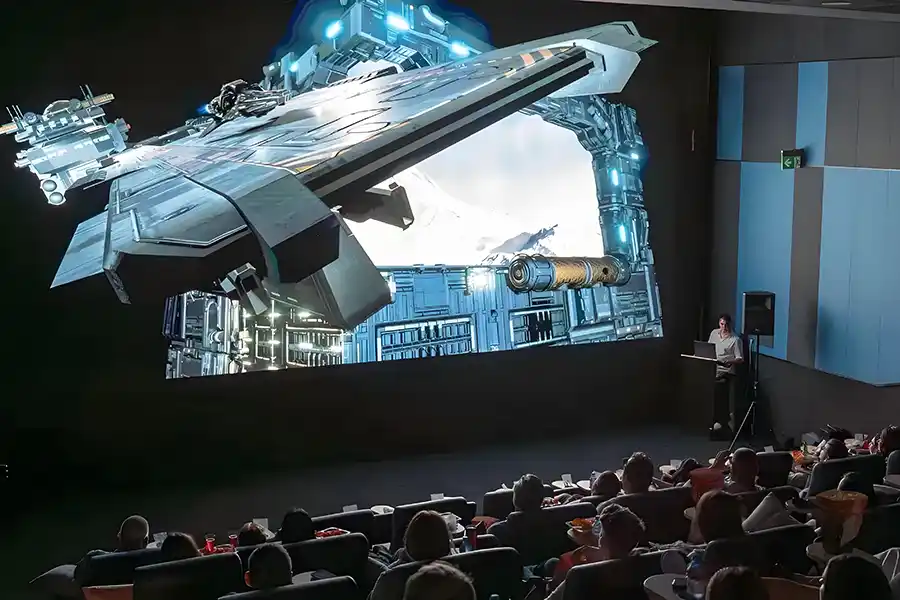
At its core, LED wall virtual production combines three major elements:
LED panel walls that display digital environments with ultra-high clarity and brightness.
Game engine technology, like Unreal Engine or Unity, to render 3D scenes in real time.
Camera tracking systems that match the virtual environment’s perspective with the camera’s physical movement.
This trio allows filmmakers to shoot actors in front of dynamic, moving backdrops that look incredibly realistic — not only to the audience but to the cast and crew on set as well. Mountains, alien planets, ancient cities, desert landscapes — all can be created and projected instantly, no travel required.
The LED walls provide actual light to the scene, casting natural reflections and ambient light on the actors and props. Unlike green screens, which require extensive post-production work to key out backgrounds and add CGI, LED walls enable directors to “get it in camera.” The footage captured looks nearly final, saving weeks or even months of post-production labor.
One of the most powerful aspects of LED wall virtual production is the level of creative control it offers. Directors and cinematographers are no longer constrained by weather, location availability, or time of day. Want a golden-hour sunset in the Sahara Desert that lasts as long as your scene requires? Done. Need a spaceship interior that seamlessly blends with a galactic backdrop? Instant.
Den här typen av frihet förändrar hur berättelser berättas. Istället för att spendera veckor på inspelningar eller bygga massiva fysiska kulisser kan kreatörer utveckla virtuella världar som är mer flexibla och kostnadseffektiva. Möjligheten att iterera, justera och förhandsgranska scener i realtid ger berättare verktyg som en gång var begränsade till stora studior med oändliga budgetar.
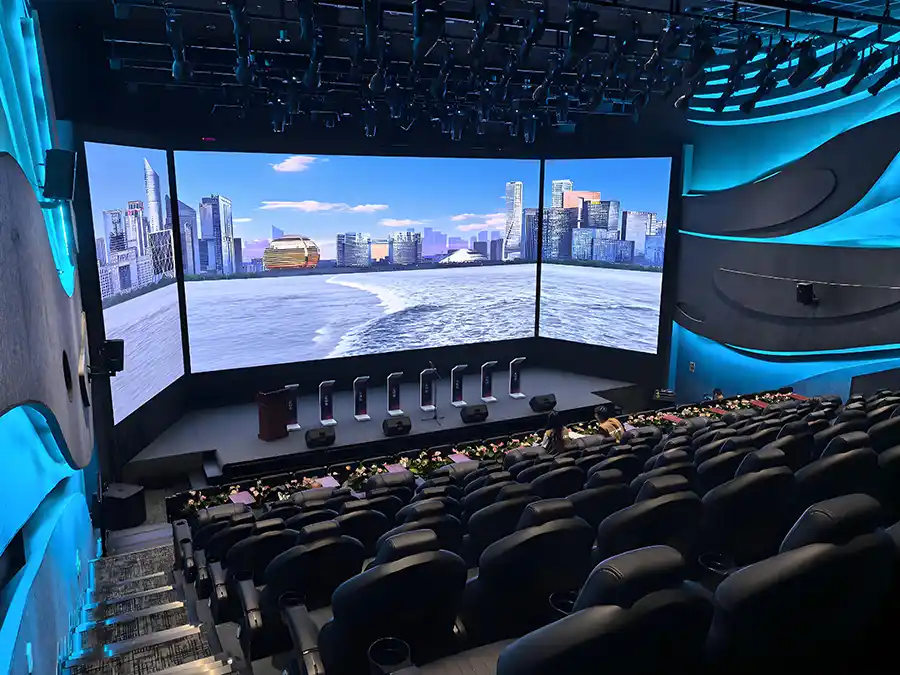
1. Visualisering i realtid
Med traditionellt green screen-arbete läggs miljön till i efterproduktionen, vilket gör att skådespelare och regissörer gissar hur den slutliga scenen kommer att se ut.LED-väggareliminera den osäkerheten. Det du ser på skärmen är vad du får – i realtid. Detta förbättrar beslutsfattandet på inspelningsplatsen och minskar behovet av kostsamma ominspelningar.
2. Naturligt ljus och reflektioner
LED-panelerna fungerar som praktiska lampor, vilket innebär att bilderna på väggen faktiskt lyser upp skådespelarna och scenografin. Detta resulterar i mer realistiska scener, eftersom miljöns belysning och reflektioner naturligt interagerar med förgrundselementen.
3. Tids- och kostnadsbesparingar
När den virtuella miljön är byggd behöver man inte resa, bygga kulisser eller vänta på perfekt väder. Man kan filma scener på flera "platser" på en enda dag. Besparingarna på resor, besättningstid och logistik kan vara enorma – särskilt för produktioner med snäva tidsramar.
4. Förbättrad skådespelarprestation
Skådespelare presterar bättre när de kan se och interagera med omgivningen. Det är lättare att reagera känslomässigt på en brinnande vulkan eller en virvlande snöstorm när den är precis framför en istället för att föreställa sig mot en grön bakgrund.
5. Flexibilitet och iteration
Behöver du ändra belysningen? Byta ut bakgrunden? Lägga till rörelse i molnen? Med några få klick är allt möjligt. Kreativa team kan anpassa sig direkt till förändrade behov utan att behöva vänta i dagar på att ändringarna ska renderas.
Det mest kända exemplet på virtuell LED-väggproduktion är DisneysMandalorianenProduktionen använde en massiv LED-volym kallad "The Volume" för att filma de flesta av scenerna. Istället för att resa till öknar, snötäckta planeter eller skeppsinteriörer byggde teamet miljöerna virtuellt och visade dem på en LED-vägg som omsluter dem. Denna metod sparade miljoner i platskostnader och visuella effekter och skapade en visuellt fantastisk show som fängslade publiken över hela världen.
Sedan dess har dussintals andra produktioner följt efter.Thor: Kärlek och åskatillBatmanLED-väggscener är nu mycket efterfrågade över hela världen.
Men det är inte bara Hollywood. Oberoende filmskapare, reklambyråer, företagsvideoteam och musikvideoproducenter ger sig in i virtuell produktion av LED-väggar. Inträdesbarriärerna minskar och mindre studior hittar sätt att skala upp tekniken för att passa sina budgetar.
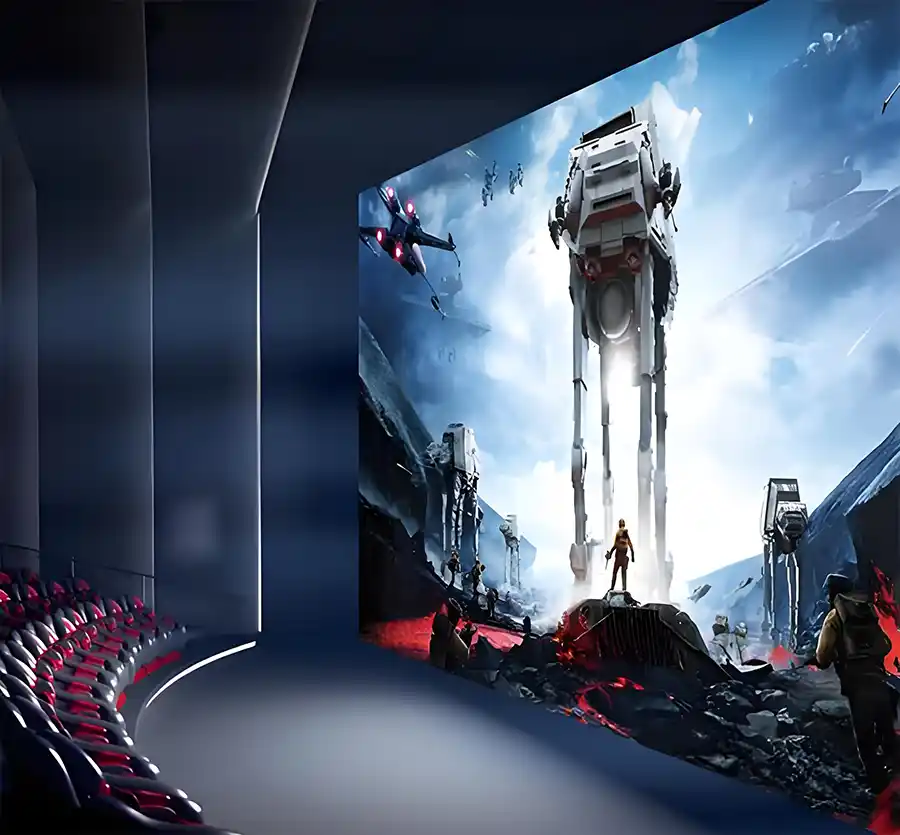
Fysiskt sett ser en LED-volym ut som en stor böjd vägg – ofta med ett tak – som består av många sammankopplade LED-paneler. Dessa paneler är modulära, vilket innebär att väggen kan anpassas till olika storlekar och former beroende på studions behov.
En typisk uppställning inkluderar:
LED panelsHög ljusstyrka, hög uppdateringsfrekvens, smal pixelavstånd
KameraspårningSensorer för att kartlägga kamerans rörelse i 3D-rymd
Rendering av servrarKraftfulla datorer som kör Unreal Engine eller liknande
BelysningsriggarSynkroniserad för att matcha miljön
KontrollgränssnittProgramvara för att justera miljöer, belysning och kameraperspektiv i realtid
Studior kan använda en 180-graders vägg, en fullständig 360-graders omslutande volym eller en mindre platt vägguppsättning för mer fokuserade bilder.
Alla LED-paneler är inte skapade lika. För virtuell produktion är flera viktiga specifikationer avgörande:
Pixel PitchMindre pixelavstånd (t.ex. 1,5 mm–2,6 mm) ger högre upplösning och bättre närbilder.
UppdateringshastighetBehöver vara hög (3840 Hz eller högre) för att undvika flimmer med filmkameror.
FärgnoggrannhetPaneler med högt bitdjup (14-bitars till 22-bitars) säkerställer rik och exakt färgåtergivning.
Ljusstyrka och kontrastViktigt för scener med varierande ljussättning eller högt dynamiskt omfång.
Toppmärken som ROE Visual, INFiLED och Unilumin har utvecklat paneler specifikt för virtuell produktion i filmklass, även om nyare konkurrenter från Kina och Sydkorea vinner framgång med konkurrenskraftiga priser och kvalitet.
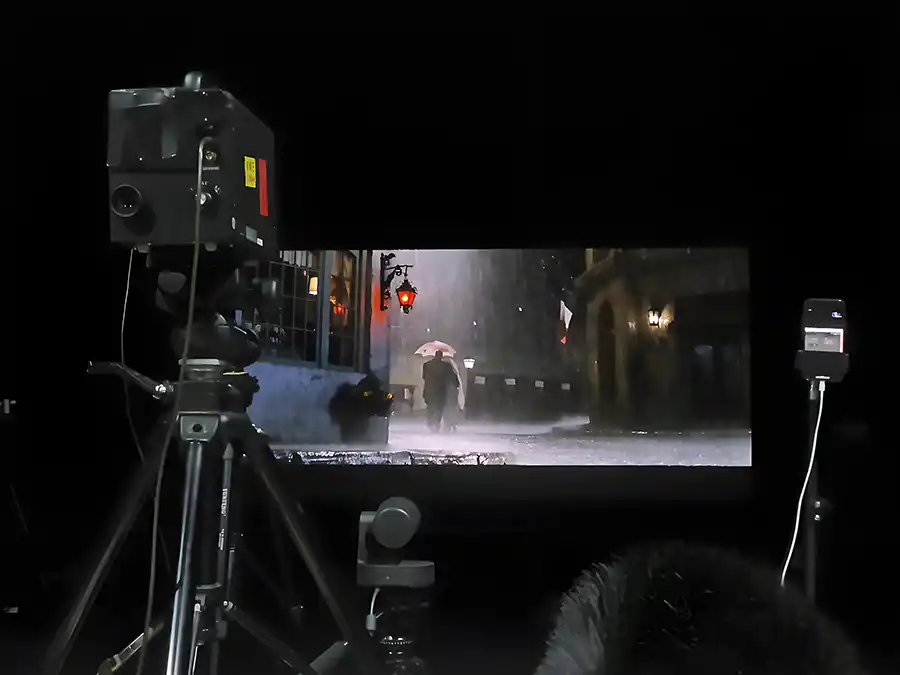
För kreatörer som funderar på att bygga sin egen installation innebär processen mer än att bara skaffa LED-paneler. En virtuell produktionsfas kräver:
UtrymmeEn ljudisolerad studio eller lagerlokal med tillräcklig takhöjd
InfrastrukturKraft-, kyl- och ventilationssystem
StödstrukturerFackverk, fästen och riggning för att hålla panelerna
SystemintegrationProgramvara och hårdvara som fungerar sömlöst tillsammans
En liten installation kan kosta 150 000–250 000 dollar, medan en full LED-volym för avancerad filmproduktion kan kosta uppåt 2 miljoner dollar.
Hyra kontra köpa
Beroende på hur ofta du planerar att använda den kan det vara ett smart alternativ att hyra en virtuell produktions-LED-vägg. Många studior erbjuder nu uthyrning av LED-volymer för daglig eller veckovis användning, komplett med teknisk support, kameraspårning och Unreal Engine-operatörer.
Att köpa är mer meningsfullt för studior med löpande produktionsbehov eller de som vill tjäna pengar på sin installation genom att hyra ut den till andra producenter. Vissa studior utforskar också hybridmodeller, där de äger en mindre installation och outsourcar större volymer vid behov.
Potentialen hos denna teknik sträcker sig långt bortom långfilmer och TV-program. Här är några av de framväxande användningsområdena:
ReklamVarumärken filmar reklamfilmer med fantastiska virtuella miljöer utan att någonsin lämna studion.
MusikvideorArtister uppträder mot digitala världar som skiftar och förändras med musiken.
FöretagsevenemangVirtuella scener ersätter green screen-webbinarier och Zoom-samtal.
Livesändningar av sportStudior använder virtuella inspelningsplatser för halvtidsshower, intervjuer och analyser.
Utbildning och fortbildningVirtuell produktion möjliggör realistiska simuleringar för militär, flyg- och medicinsk utbildning.
I takt med att kostnaderna sjunker och arbetsflödena standardiseras, kommer virtuell produktion av LED-väggar att bli en stöttepelare inom en mängd olika branscher.
Vi är fortfarande i början av den här tekniken. I takt med att renderingsmotorer förbättras, LED-paneler blir skarpare och effektivare, och AI integreras djupare i processen, kommer gränsen mellan fysisk och virtuell produktion att fortsätta att suddas ut.
Föreställ dig helt interaktiva kulisser som förändras som svar på skådespelarnas rörelser. Eller virtuella platser som anpassar sig till publikens feedback i realtid. Eller molnanslutna produktionsscener där globala team kan samarbeta i realtid.
Det här är inga avlägsna drömmar. De prototyperas redan i studior runt om i världen.
Virtuell produktion av LED-väggar är mer än en teknologisk trend – det är en kreativ utveckling. Den sammanför filmskapare, speldesigners, ingenjörer och konstnärer under ett digitalt tak, vilket ger dem möjlighet att bygga världar som en gång var omöjliga eller oöverkomligt dyra.
För alla som arbetar med visuellt berättande är det nu dags att utforska denna gräns. Oavsett om du producerar storfilmer eller nischinnehåll kan den här tekniken erbjuda den realism, effektivitet och flexibilitet som en modern publik kräver.
Och i takt med att fler skapare anammar det, kommer den virtuella horisonten bara att fortsätta att expandera.
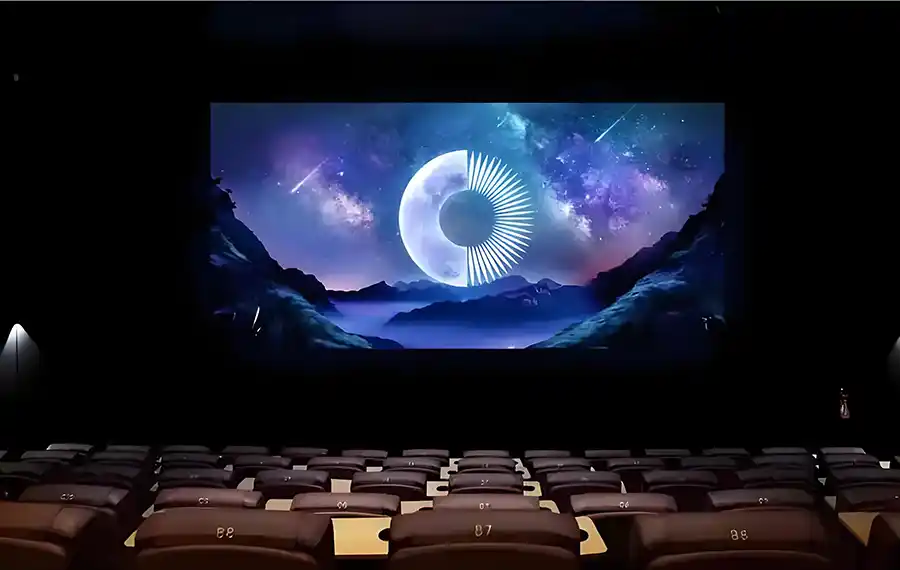
1. Kan virtuell LED-väggproduktion användas för livestreaming av evenemang eller konserter?
Ja, det blir alltmer populärt vid liveevenemang, inklusive konserter, e-sport, produktlanseringar och varumärkesupplevelser. LED-väggarna kan integreras med realtidsrenderingsmotorer för att skapa dynamiska, interaktiva bakgrunder som svarar på musik, ljussignaler eller input från publiken. Till skillnad från traditionella scenskärmar möjliggör virtuella produktions-LED-väggar fullständiga 3D-miljöer och kamerasynkroniserade bilder, vilket gör upplevelsen mer uppslukande för både publik på plats och på distans.
2. Vilken typ av kamerautrustning är kompatibel med virtuell LED-väggproduktion?
De flesta professionella digitala filmkameror är kompatibla, men för att få bästa resultat vill du ha ett kamerasystem som stöder genlock (för synkronisering) och har en global slutare eller rullande slutare optimerad för miljöer med hög uppdateringsfrekvens. System som ARRI, RED och Sony Venice används ofta. Vissa inställningar inkluderar även linskodningssystem för att ge korrekt brännvidd och fokusdata till renderingsmotorn för bättre parallaxmatchning.
3. Hur mycket teknisk expertis krävs för att köra en virtuell produktionsuppsättning?
En hel del. Du behöver specialister inom flera områden:
Unreal Engine eller realtidsrenderingför miljöskapande och -hantering
LED-teknikerför att övervaka panelens prestanda och hantera skärmkonfigurationen
Experter på kameraspårningför att säkerställa exakt rörelseöversättning
Färgläggare och DIT:erför att hantera bildkonsistens på inspelningsplatsen
Ljusdesigners och scenograferatt blanda fysisk rekvisita med virtuella bakgrunder
Medan vissa mindre studior kan utbilda sina befintliga team, anställer större produktioner ofta dedikerade virtuella produktionsledare och tekniker.
4. Hur förhindrar man moirémönster eller visuella artefakter när man filmar LED-väggar?
Moirémönster kan uppstå när pixelnätet på LED-väggen stör kamerans sensormönster. För att minska detta:
Använd kameror med sensorer med högre upplösning
Justera fokus för att göra bakgrundsväggen något suddig
Välj LED-paneler med en finare pixeltäthet (1,5 mm eller mindre)
Använd diffusionsmaterial när det är lämpligt
Kalibrera väggen och kameravinkeln för att undvika direkta störningar
Korrekt förvisualisering och testning är avgörande innan filmningen börjar.
5. Kan virtuell produktion av LED-väggar kombineras med fysiska inspelningsplatser?
Absolut. Många produktioner använder"hybriduppsättningar", där fysiska rekvisita, strukturer eller terräng byggs i förgrunden, och LED-väggen hanterar bakgrunden och himlen. Denna hybridmetod förankrar scenen med konkreta element samtidigt som den ger kreativ frihet för den virtuella världen. Det hjälper också till med djupuppfattning och ljusrealism.
6. Hur lång tid tar det att bygga en virtuell miljö för LED-väggproduktion?
Det beror på komplexiteten. En enkel miljö som en skogsglänta eller ett inomhusrum kan ta några dagar till en vecka. En detaljerad sci-fi-stadsbild eller dynamisk väderscen kan ta flera veckor, särskilt om den behöver reagera på kamerarörelser i realtid.
Återanvändning av miljöer över flera scener eller avsnitt kan spara tid, och många studior har nu digitala miljöbibliotek som påskyndar förproduktionen.
7. Finns det licensavgifter för att använda spelmotorer som Unreal Engine i virtuell produktion?
Unreal Engine är gratis att använda för många ändamål, inklusive film- och virtuell produktion. Men om du utvecklar interaktiva upplevelser eller kommersiella produkter (som spel eller simulatorer) kan intäktsdelning eller företagslicenser tillkomma. För filmisk användning har Epic Games en stark närvaro i branschen och arbetar ofta direkt med studior för att stödja virtuella produktionsplaner.
8. Kan virtuell produktion av LED-väggar göras i små utrymmen?
Ja, men det finns begränsningar. Mindre LED-vägguppsättningar kan fungera bra för trånga tagningar, intervjuer, musikvideor eller produktioner med en kamera. Kamerarörelser och vidvinkelbilder blir dock mer utmanande i trånga utrymmen. Smart scenografi, kreativ inramning och objektivval kan hjälpa till att övervinna dessa begränsningar. För mindre studior kan en delvis LED-vägg i kombination med smart belysning och minimal fysisk scenografi fortfarande ge professionella resultat.
9. Hur fungerar ljudinspelning på en LED-scen? Låter det från panelerna?
Högkvalitativa LED-paneler är vanligtvis tysta, men kylfläktarna på stora paneler kan skapa omgivande ljud. För scener med känsligt ljud använder produktioner ofta:
Riktade bommikrofoner med brusreducering
Lavaliermikrofoner gömda på skådespelare
Post-dubbed dialog (ADR) i extrema fall
Akustisk behandling på inspelningsplatsen för att minska reflektioner och brusutsläpp
Vissa nyare LED-modeller har fläktlösa eller ultratysta design specifikt för virtuella produktionssteg.
10. Finns det miljö- eller energiproblem med att använda LED-väggar i stor utsträckning?
LED-paneler förbrukar avsevärt energi, särskilt vid stora produktionsvolymer. Dessutom genererar de värme, vilket kräver kylsystem och ordentlig ventilation. Jämfört med fysisk scenografi, resor på plats och traditionella belysningsriggar kan dock virtuell produktion minska den totala miljöpåverkan i många fall. Vissa studior använder också förnybara energikällor och effektiva kylsystem för att minimera sitt koldioxidavtryck.
Heta rekommendationer
Heta produkter
Get a Free Quote Instantly!
Prata med vårt säljteam nu.
Om du är intresserad av våra produkter, vänligen kontakta oss omgående
Kontakta vårt säljteam för att utforska skräddarsydda lösningar som perfekt möter dina affärsbehov och lösa alla frågor du kan ha.
E-postadress:info@reissopto.comFabriksadress:Byggnad 6, Huike Flat Panel Display Industrial Park, nr 1, Gongye 2nd Road, Shiyan Shilong Community, Bao'an District, Shenzhen, Kina
whatsapp:+86177 4857 4559